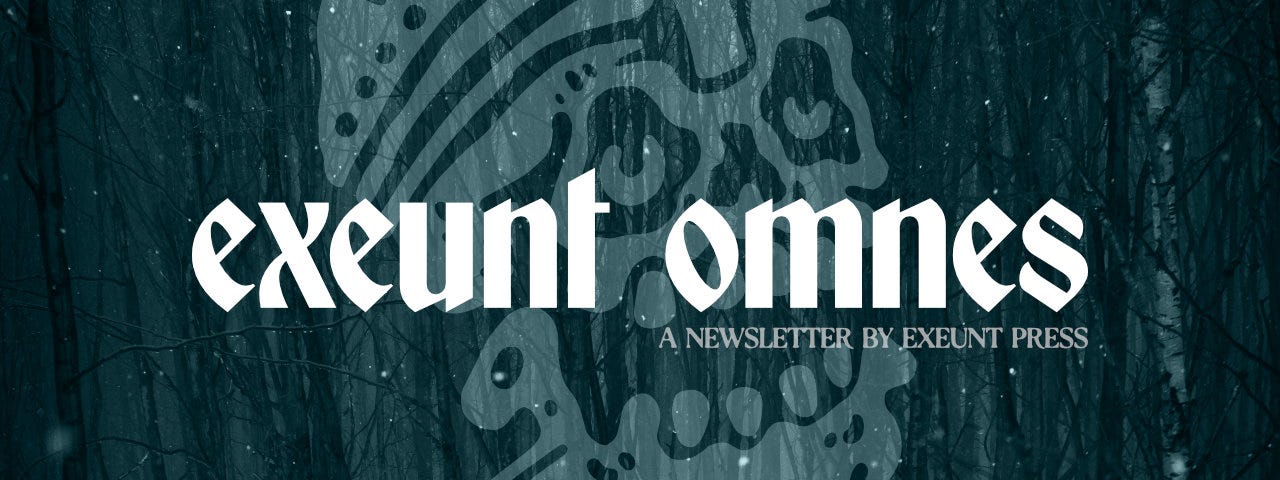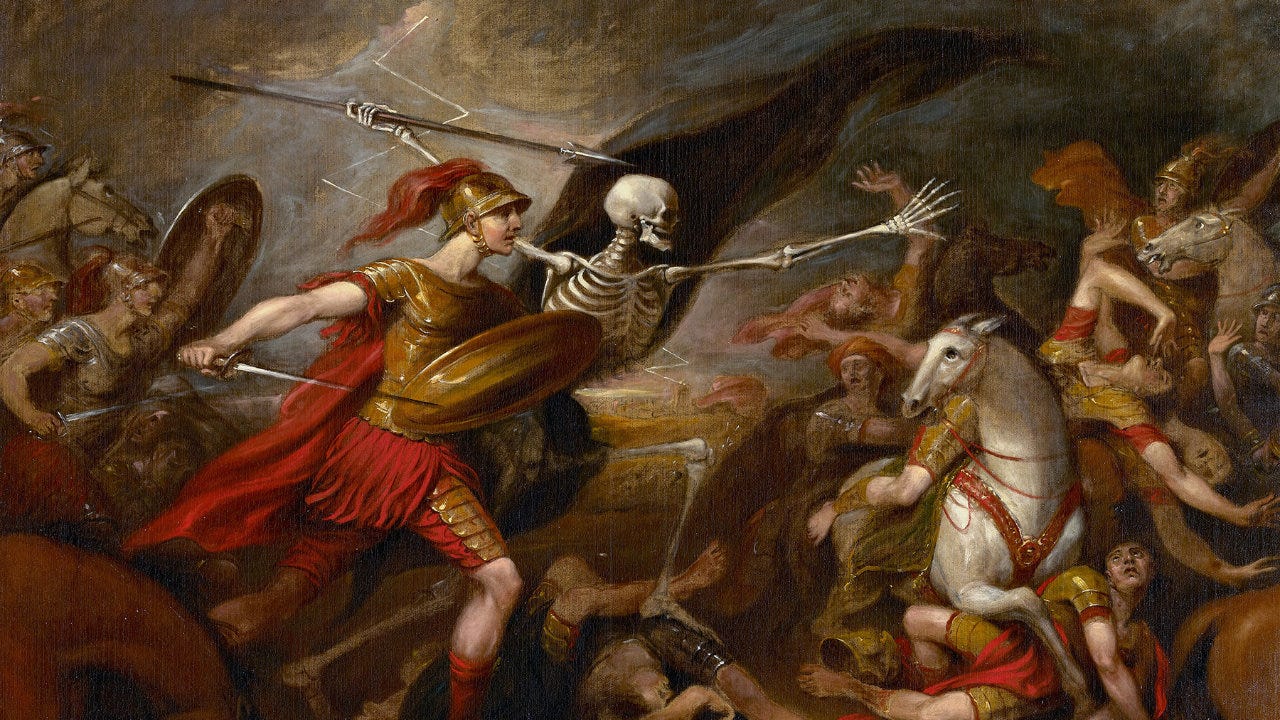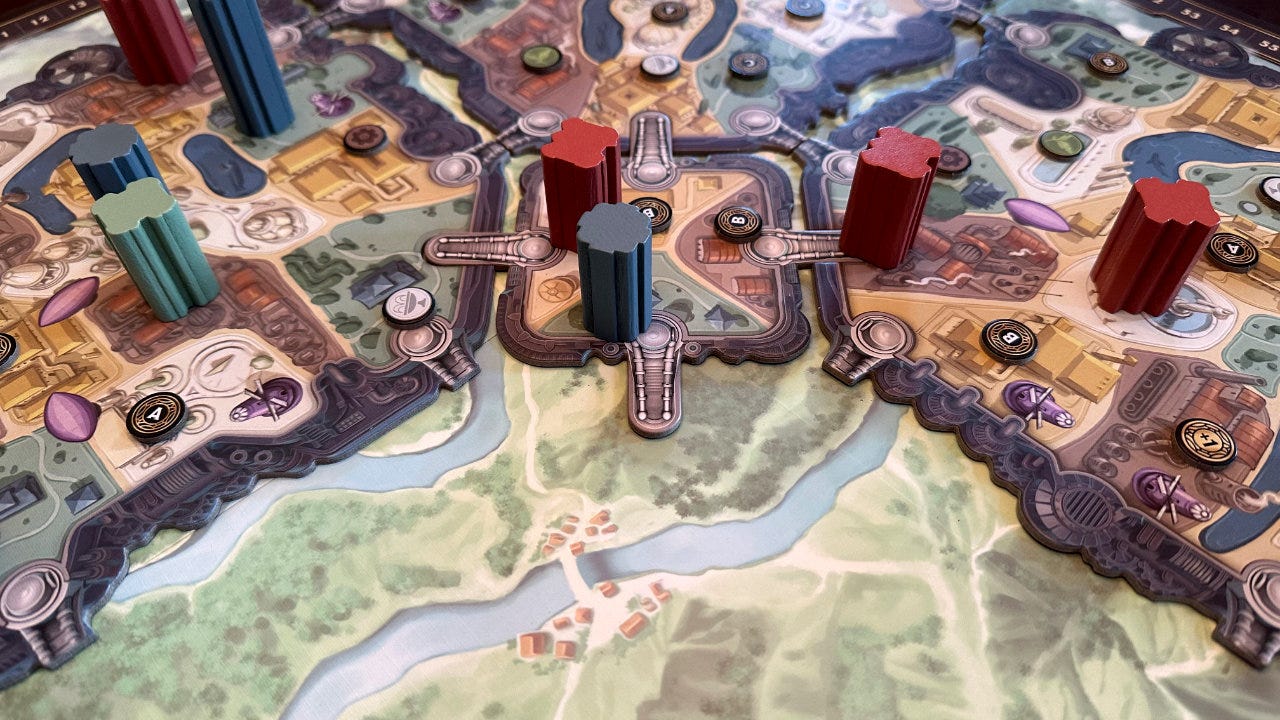What is a solo TTRPG?
Ratsail, Medusa, Player Death, Solo TTRPGs, and Skyrise
Welcome to Exeunt Omnes, the official newsletter for loyal fans and sworn enemies of Exeunt Press, creator of games such as Exclusion Zone Botanist and Eleventh Beast. You can find digital games at games.exeunt.press and physical products at shop.exeunt.press.
TL;DR Summary
🐀 Ratsail, Medusa, and more
💀 Bosman’s Typology of Player Death
✍️ What is a solo TTRPG?
🎲 Recently played: Skyrise
Ratsail, Medusa, and more
Some recent releases from Exeunt Press include Blackflower (a CY_BORG heist) and Three Knife Ash (a collection of pirate dice games).
With less than 183 days left in 2024, here are some other projects in the pipeline:
Ratsail: Based on extremely valuable playtesting feedback, this one is getting a significant re-write. The core mechanisms are complete, and rules writing continues. It’ll need some more playtesting, and then layout. This is the largest project Exeunt Press has attempted, and I’m extremely excited for its release.
Medusa: A solo space survival horror TTRPG. This started using a hexcrawl as the core mechanism, but is turning into more of a point crawl. I don’t partake in a lot of sci-fi, so this one is a fun diversion.
Black Rain & Fire: This is a large MÖRK BORG adventure supplement, expanding on the world created by Hammer of a Killing Crown, A Pale Ground Covering All, and Waves to be as Mountains.
Other MÖRK BORG thing: A supplement with two new character classes, items, and a one-shot adventure. This will probably be added to the existing Exeunt Press MÖRK BORG Bundle.
Untitled one-page TTRPG: I have an idea for another trifold TTRPG, similar in scope to Exclusion Zone Botanist and Eleventh Beast. Focused on Faustian Bargains. No writing or layout yet, just ideas. Might get tied into a game jam.
MÖRKTOBER: Hard to believe MÖRKTOBER begins in about 90 days! I’m hoping to have Black Rain & Fire available by then, but also a special event.
I generally try to keep projects quiet until they are almost complete. This goes directly against the advice of Austin Kleon’s Show Your Work. Austin is right, of course, but that’s easier said than done. So I hope you enjoy this little peek at what is coming up!
SHOP: Blackflower and other games at the Exeunt Press Shop
💀 Bosman’s Typology of Player Death
I recently wrote about Bosman’s Typology of Player Death and how it relates to both video games and tabletop games. It’s an important topic because “not dying” is a key driver in many of the games we play.
The typology divides death in games into three major types:
Embedding: Actual death.
Embedding: Death avoided.
No explicit narratological embedding.
Each has a few sub-types (e.g. Type 1A, 1B, 1C) with important distinctions. Type 1A relies on your character being cloned/copied while Type 1C just has you grabbing control of the next available avatar.
You can use Bosman’s Typology to make death meaningful, analyze the games you enjoy, and bridge the gap between video game and tabletop game design.
READ: Bosman’s Typology of Player Death at Skeleton Code Machine
Skeleton Code Machine is a weekly publication that explores tabletop game mechanisms in board games and roleplaying games. It’s been called a “Seemingly endless source of gaming ponderings” and a “Goldmine.” Check it out at www.skeletoncodemachine.com.
✍️ What is a solo TTRPG?
I’ve been a little obsessed with wargames lately, and doing a lot of reading about them. Particularly, some reading about early wargame design in the 1960s - 1980s. Read the related What is a wargame? And does it matter? and Wargames, nostalgia, and Tactics II for more.
I ended up coming up with a list of some common elements of wargames, with items such as “map-based gameplay” and “victory conditions.”
What was really interesting to me was that some of the most interesting wargames broke those conventions, skipping or significantly changing those core elements. The King is Dead and Twilight Struggle have no direct combat resolution. Some games don’t have victory conditions.
This got me thinking about solo TTRPGs, a genre that I’ve enjoyed exploring via Exclusion Zone Botanist and Eleventh Beast. What are the common elements? How do we explain to someone what a solo TTRPG is?
Here are my thoughts:
Control of a single character: Almost every solo TTRPG I can think of exists at a tactical level vs. an operational or strategic level. This means the player controls a single character or avatar in the game, rather than a group of characters. A notable exception (while not officially a solo game) is The Quiet Year.
Narrative gameplay: Most solo TTRPGs are, at their core, story-telling games. The narrative is inextricably linked to the mechanisms and the gameplay. In many ways, they are story-telling first and mechanical games second.
Procedural generation: I mean procedural generation in the broadest sense of the term. The game provides tools or tables to create the world of the game. Each game can be a unique experience because the characters, events, encounters, and locations can be randomly generated, but in the best games still feel linked together in a coherent way.
Oracle systems: Instead of relying on a Game Master (GM), an oracle system is a way for the game to determine the result of an action or question posed by the player. It could be rolling a d6 and interpreting the results as Yes/No, or the the many options in between (“Yes, but…”, “Yes, and…”, “No, but…”). It could also be more complicated, relying on the character’s abilities or stats and specialized dice.
Exploration: Solo TTRPGs like those based on the Carta SRD are focused on exploration. This could be because it fits so well with both narrative gameplay and procedural generation. Exploration games also may not require maps to be made ahead of time, instead having the player create their own map as they go.
Journaling: Although not all solo TTRPGs have journaling, I think it’s a significant aspect to include. It’s a way for player’s to expand the narrative elements of the game as much or as little as they would like, documenting their character’s thoughts and actions. It’s a great way to create an artifact of play that lasts after the game has ended. It can also be optional as it is in Exclusion Zone Botanist.
Simplified rules: While I’m sure there are some complicated solo TTRPGs out there, many have very light rules. This is probably due to the focus on narrative gameplay as noted above, rather than mechanical gameplay. Of course complexity is subjective and depends on your level of experience. Some might consider Ironsworn complicated, while others would maintain that it’s quite simple.
Much like how I ended up replacing “combat resolution systems” with “thematic mechanisms” when thinking about wargames, I’m sure I will make changes to this list as well.
Having a list of common elements can be useful, however, when trying to make unconventional games. Which of these elements can be excluded, changed, or inverted to make something new and innovative?
What do you think? Does this cover the main elements common to solo TTRPGs or did I miss some important ones? Which elements are the most important?
🎲 Recently played: Skyrise
Skyrise is a fairly abstract 2-4 player area majority game that uses bidding as its core mechanism. Just released this year, I hadn’t even heard of it before getting a chance to play it this weekend.
Ostensibly the theme is something about visionaries building a “magnificent city in the sky” dedicated to art and science. I’m not sure it makes much sense, but the gameplay was a lot of fun. You use little numbered towers to position and bid on a map that becomes increasingly tight as the game progresses.
The production was really great, which is to be expected from Roxley. They are the company behind Brass: Birmingham, Radlands, Santorini, and Dice Throne.
PLAY: Skyrise designed by Gavan Brown, Sébastien Pauchon, and Adam Wyse
Thanks for subscribing to Exeunt Omnes!
Check out games.exeunt.press for all the latest games and resources!
- E.P. 💀






Ah! I love the 'what is a solo TTRPG' discussion. I think your (Exuent Press) definition hits the mark for the vast majority of solo RPGs, but I've always looked at Solo RPGs as a bell curve. The bell portion in the middle represents the vast majority of solo RPGs and most games (although not all) adhere to the elements your list. But the two wings are where things can drift a bit.
On the right of the bell, I define as "Where is the Roleplay in my Game?" This is where I place gamebooks like The Lone Wolf and Fighting Fantasy that contain some roleplay elements, but are mostly on rails. Also included are some dungeon delver games with roleplay elements (Four Against Darkness) and skirmish games with roleplay elements (Five Parsecs from Home and the like).
On the left of the bell is 'Where is the Game in my Roleplay?' Mostly I place some journaling games that seem more concerned with allowing you to craft amazing stories, and less so about game mechanics and exploration. Maybe Bucket of Bolts and Untitled Moth Game go here.
Funny enough I made a 'game' so far into the left of the bell I felt it wasn't even a game at all and was a poem generator (but I thought it was fun and clever). And in some Solo RPGs I'm working on, I'm seeing if I can play with those elements you've defined to create fresh solo experiences.
Anyway, keep up the excellent newsletters!
About solo games, there are also a lot of games which are lyrical/rituals/meditative/about care or thinking without journaling and no oracles. That’s a full and expansive family of solo experiences (I truly love). At the ‘left of the bell’ according to Croaker’s great comment :)